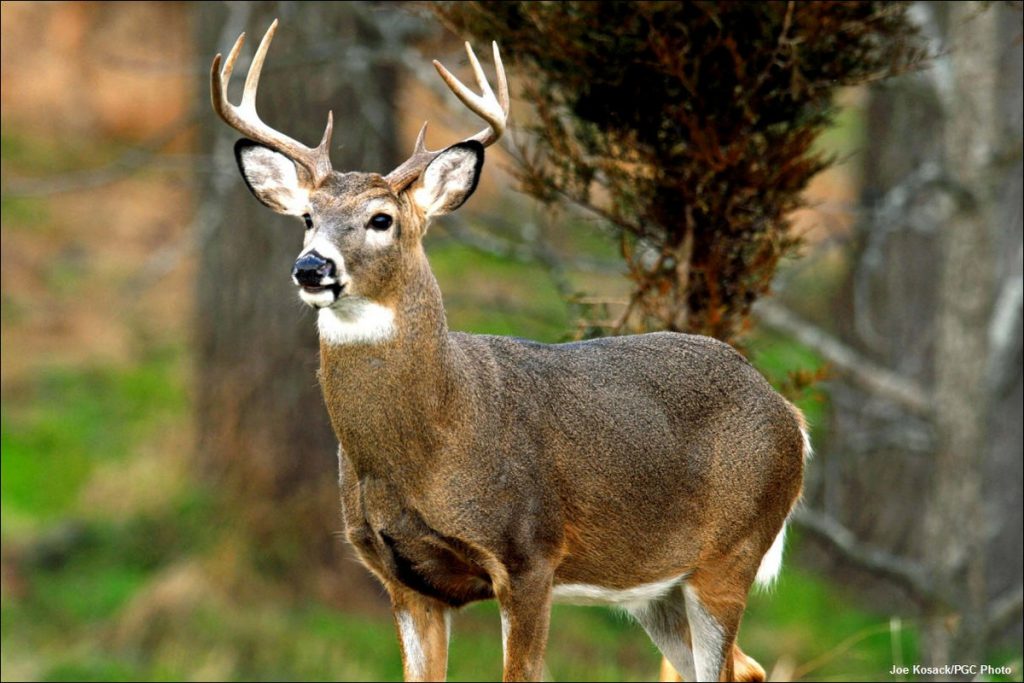I love picking up the deer magazines at the barber shop come September and October to read about the rut. So much to learn about the upcoming season!
First, there are regional appraisals about what will happen with the rut around the country and when.
Then there are the experts who can tell you how the moon phase will affect rut behavior.
But just what is the rut and when does it occur in Pennsylvania? Turns out we’ve got the data to let you in on a little secret!
The rut is when bucks go crazy trying to breed. A single buck can breed several doe, so all the more reason for them to go crazy! Bucks need to first find a doe who is ready to be bred – the reason why they run (literally!) all over the place during the rut – and then defend that receptive female from other males.
It’s the only time of year that deer are territorial, but it’s not about defending some piece of land. It’s about excluding other males from breeding with a receptive female! A different type of territorial behavior for sure – the “territory” (the female) just happens to move around – but territorial behavior nonetheless.
Because the rut is about breeding, we can determine when the rut occurs by determining when fawns are born. The way we do this is to check road-killed does for embryos in late winter and early spring. If they are pregnant we can measure the length of the fetus and estimate the date the doe was bred. During 1999-2006, the PA Game Commission checked 3,507 road-killed does with fetuses.
But we might want some additional information.
During 1999-2006, here’s when the full moon occurred.
| Year | Full Moon |
|---|---|
| 1999 | 23 Nov |
| 2000 | 11 Nov |
| 2001 | 01 Nov |
| 2002 | 20 Nov |
| 2003 | 09 Nov |
| 2004 | 26 Nov |
| 2005 | 16 Nov |
| 2006 | 05 Nov |
But first, a definition. A median date is where half the dates are below the median value and the other half are above it. The median is similar to the mean, but less influenced by a few extremely large or small outlier data points.
The median date of the full moon was 13-14 Nov during 1999-2006.
The variation about this date averaged +/- 9 days. So that variation in the date of the full moon has the potential to change the timing of the rut from one year to the next!
Now what was the median date of conception during those years?
| Year | Adults | Fawns |
|---|---|---|
| 1999 | 11 Nov | 30 Nov |
| 2000 | 15 Nov | 24 Nov |
| 2001 | 10 Nov | 28 Nov |
| 2002 | 16 Nov | 26 Nov |
| 2003 | 14 Nov | 17 Nov |
| 2004 | 12 Nov | 23 Nov |
| 2005 | 09 Nov | 22 Nov |
| 2006 | 14 Nov | 26 Nov |
Across all years, the median date of conception for adult does was 13 November (based on 190-436 doe checked/year).
Wow! The median date of the full moon is the same as the median date of conception for adult does. There must be a connection!
For fawns, it was similar but sample sizes are smaller (17-87 doe checked/year). The median date of conception across all years was 25 November. Hmm… 2 weeks later?
Now all we need to do is correlate the date of the full moon with the median date of conception and figure out how to plan for the rut each year! Check out the graph below.

But wait a minute! No matter the date of the full moon the median date of the rut simply bounced around 13 November for adults and 25 November for fawns. There is no relationship between the rut and the moon.
Turns out, that’s the secret!!!
The rut really doesn’t vary that much from year to year. The secret is you can plan your hunting vacation around the rut months ahead of time and not even worry about the moon!
But why does the rut peak for fawn females about 2 weeks later than adults? We’ll discuss that in an upcoming post real soon but it has little influence on the timing of the rut (compared to adults there are relatively few fawns that breed). Combining adult and fawn data the median date of the rut is only 1 day later – 14 November.
Soon we’ll be sharing deer movements of males during the rut. So we’ll first have to show you the variation in breeding dates of females (it doesn’t all occur on the median date!).
Please check back for updates or sign up for email notices of new posts.
-Duane Diefenbach
If you would like to receive email alerts of new blog posts, subscribe here.
And Follow us on Twitter @WTDresearch
